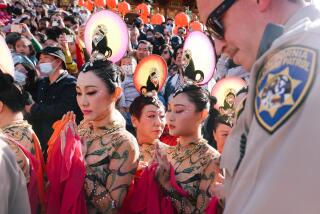Traditional Rites Mark Vietnamese New Year
- Share via
Vietnamese in the San Fernando Valley sang ballads about being away from home during the holiday and passed out red lucky-money envelopes Sunday to welcome the Year of the Snake.
The New Year’s celebration, or Tet, began last Monday with many of the Valley’s 15,000 Vietnamese residents meeting for family dinners and praying “for unification of the family, freedom of our country, and for the boat people who are in camps,” said Thanh Nguyen, 46, of Northridge. “You pray for the better,” he said.
The New Year is the most important Vietnamese holiday, said Hao Doan, coordinator of the Southeast Asian Community Center. “It’s a combination of the American Thanksgiving, New Year, Christmas and Happy Birthday,” he said. Traditionally, ages are counted on the New Year, not on one’s birthday, “so it’s happy birthday to all of the children and people,” he said.
At the Vietnamese Language School celebration in Reseda on Sunday morning, a yellow and red banner wished the 90 parents and children Cung Chuc Tan Xuan , or “Happy New Year.”
Four women, in elegant white traditional dresses, ao dai, plucked dan tranh, instruments similar to Japanese kotos. Another performer sang a ballad about a soldier who is spending the New Year on the front line and misses his mother. “When I hear that song, it makes me feel sad,” said Van Nguyen, who was a soldier and police officer in Vietnam and now works as a plumber.
After the children chimed wishes for longevity, luck and prosperity, they were given bright red li xi, lucky-money envelopes with $1 tucked inside. “It’s important to celebrate the New Year, so the youngsters understand it and so they learn how to wish the wishes like I used to do with my parents,” said Mai Nguyen, 30, a mother of three.
In a variety show Sunday evening organized by Cal State Northridge Vietnamese students, there were modern and traditional Vietnamese songs and dances with a few American touches. The 300 people stood for both the American and South Vietnamese national anthems. A rock band of CSUN students played Vietnamese pop tunes and “La Bamba.”
Black and red dragons with pop-eyes and ferocious eyebrows and mouths were operated by students from Luezinger High School in Lawndale. They pranced up the aisles of Canoga Park’s John A. Sutter Junior High School Auditorium, leaped onto the stage, and rolled over like dogs to ward off evil spirits. People in the audience came up to offer the dragons money for good luck.
The New Year also is marked by wearing red, a lucky color, and eating sticky rice dyed red, dried yam, persimmon, pineapple, ginger and lotus seeds, and mut, a sweetened squash.
Traditional Foods
Families feast on banh chung and banh day, square and round pillows of sticky rice, pork and beans in bamboo leaves. Doan said the sticky rice packages have a story that goes back 4,000 years, when Hung Vuong, the first king of Vietnam, asked his sons to bring him something that would prove which one was worthy of succeeding him.
The winner, Lang Lieu, brought the cakes: the square symbolized the Earth and yang, the positive, masculine force. The round one symbolized yin, the negative, feminine element and the sky. And the rice inside represented the importance of agriculture in Vietnam.
Many of the Vietnamese New Year’s traditions are similar to the Chinese, Doan said.
In Vietnam, the holiday brought three days of vacation, trips to ancestors’ graves and visits with family and friends. “Here, we have to work on New Year’s,” Phi Khuong of Sepulveda said with a laugh.
“It’s nothing compared to what we do in Vietnam,” said Thanh Vu, president of the Vietnamese Student Assn. at CSUN.
More to Read
Sign up for Essential California
The most important California stories and recommendations in your inbox every morning.
You may occasionally receive promotional content from the Los Angeles Times.










